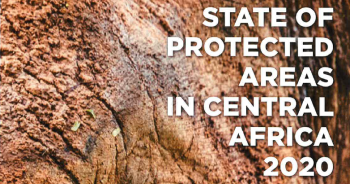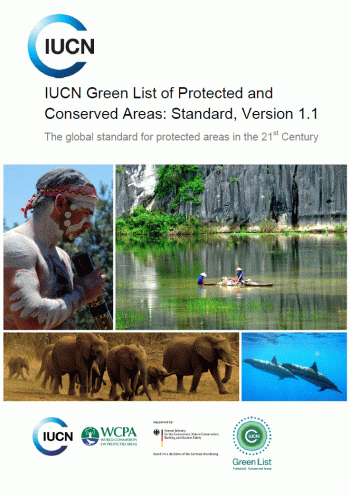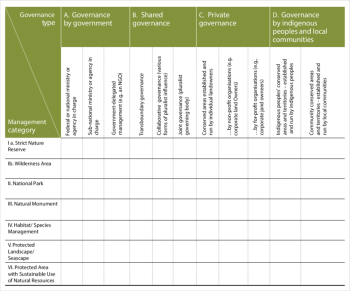PAGE Assessment Tools

Synoptic table and overview of the main tools used to support decision-making on protected areas
Overview of available tools - produced in the frame of the elaboration of the Central Africa 2020 SoPA report - provides a synoptic table and an overview of the available tools in support to protected areas to carry out both PAME and PAGE assessments
Overview of available tools - produced in the frame of the elaboration of the Central Africa 2020 SoPA report - provides a synoptic table and an overview of the available tools in support to protected areas to carry out both PAME and PAGE assessments

IUCN Green List of Protected and Conserved Areas
The IUCN Green List of Protected and Conserved Areas is the first global standard of best practice for area-based conservation. It is a programme of certification for protected and conserved areas – national parks, natural World Heritage sites, community conserved areas, nature reserves and so...
The IUCN Green List of Protected and Conserved Areas is the first global standard of best practice for area-based conservation. It is a programme of certification for protected and conserved areas – national parks, natural World Heritage sites, community conserved areas, nature reserves and so on – that are effectively managed and fairly governed. By giving recognition to well-managed and well-governed protected and conserved areas, the IUCN Green List aims to increase the number of natural areas delivering long-lasting conservation results for people and nature.
How it works
Sites join the IUCN Green List by committing to achieving its standard. They become certified once they demonstrate a high bar of environmental and social performance. The IUCN Green List Standard addresses four themes: good governance, sound design and planning, effective management, and positive conservation outcomes. The time from application to certification depends on the management quality of the site at the time of application. Sites choose when they are ready for evaluation, and have up to a maximum of five years to achieve certification, which is valid for a five year period. During that time, sites are regularly evaluated and reviewed against a set of demanding criteria. Enrolled sites therefore benefit from expert guidance on how to improve their performance and impacts. They also become part of a network, fostering exchange and learning among conservation practitioners.
The IUCN Green List Standard provides a global framework for assessing, improving and recognizing the performance of protected and conserved areas; however, as such it is not one of the common methodologies to evaluate the governance or equity of protected and conserved areas. Other assessment tools introduced in this PAME Dashboard, such as GAPA, SAPA and SAGE, have been developed for that purpose and can also support protected and conserved areas in the Green Listing process.
For further information on IUCN Green List of Protected and Conserved Areas please refer to:
IUCN Green List of Protected and Conserved Areas: Standard, Version 1.1
IUCN Green List of Protected and Conserved Areas: User Manual, Version 1.2
Please check the IUCN Green List website to make sure you use the latest Standard and User Manual: https://iucngreenlist.org/

Site-level Assessment of Governance and Equity (SAGE)
Site-level assessment of governance and equity (SAGE) is one of three tools for stakeholders and rightsholders to themselves assess the social impacts, governance and equity of their conservation efforts.
Site-level assessment of governance and equity (SAGE) is one of three tools for stakeholders and rightsholders to themselves assess the social impacts, governance and equity of their conservation efforts.
Social Assessment for Protected and Conserved Areas (SAPA)
Social assessment for protected and conserved areas (SAPA) is one of three tools for stakeholders and rightsholders to themselves assess the social impacts, governance and equity of their conservation efforts.
Governance Assessment for Protected and Conserved Areas (GAPA)
Governance assessment for protected and conserved areas (GAPA) is one of three tools for stakeholders and rightsholders to themselves assess the social impacts, governance and equity of their conservation efforts.
Natural Resource Governance Tool (NRGT)
This tool was developed by the Wildlife Conservation Society (WCS) for assessing natural resource governance.
The guide provides one approach that can be used to identify the most important groups with rights to govern natural resources within a geographic area, to establish the factors...
This tool was developed by the Wildlife Conservation Society (WCS) for assessing natural resource governance.
The guide provides one approach that can be used to identify the most important groups with rights to govern natural resources within a geographic area, to establish the factors deemed to be essential elements of good natural resource governance, and to assess the strengths and weaknesses of each governance group. The guide describes an approach and a data collection tool that together constitute a simple, low-cost, expert opinion-based method for assessing natural resource governance groups.
The second version of the tool incorporates: a) improved understanding of the power to govern and the addition of diversity as a sub-attribute of authority, b) updated data collection and data management methods using KoboToolBox on tablet computers, and c) revision of the survey instrument to use Likert scale responses. Each of these changes were informed by extensive field experience of implementing the first version of the tool in Central Africa and other locations around the world.
Citation: Detoeuf, D., Wieland, M, Cowles, P. and Wilkie, D. 2020. The Natural Resource Governance Tool - Version 2. WCS Bronx, NY and USAID Washington, D.C. USA
MJUMITA Village Forest Governance Dashboard
This tool is a process designed to assist villages engaging in participatory forest management (PFM) to adopt best practices in relation to village forest governance. The tool helps communities to identify obstacles to good governance and to establish practical action...
This tool is a process designed to assist villages engaging in participatory forest management (PFM) to adopt best practices in relation to village forest governance. The tool helps communities to identify obstacles to good governance and to establish practical action plans to overcome those obstacles. The tool was designed by MJUMITA, the Community Forest Conservation Network of Tanzania as part of the Forest Justice in Tanzania initiative. The tool relies on strong, independent, voluntary community forums or networks, operating alongside the formal village forest governance authorities. The tool has been used in Tanzania to conduct self-governance assessment in over 400 villages participating in PFM.
Citation: MJUMITA. 2014. Monitoring Village Forest Governance with the MJUMITA Dashboard Tool. Policy Brief. Community Forest Conservation Network of Tanzania (MJUMITA) and Tanzania Forest Conservation Group (TFCG), Dar es Salaam, Tanzania.

System-level Assessment of Governance
